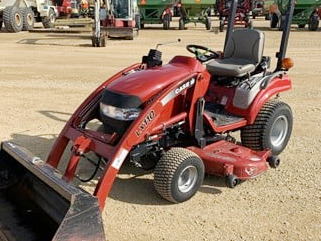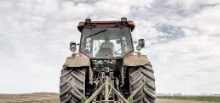________________________________________________________________________________________
| Home / Farm Tractors / Case IH Tractors / Case IH DX25E |
Case IH DX25E Troubleshooting
 The
Case IH DX25E sub-compact utility tractor was manufactured between 2005 and
2007. The Case IH DX25E driveline consists of Shibaura S773 three-cylinder
liquid-cooled diesel engine, and hydrostatic transmission with infinite forward
and reverse gears.
The
Case IH DX25E sub-compact utility tractor was manufactured between 2005 and
2007. The Case IH DX25E driveline consists of Shibaura S773 three-cylinder
liquid-cooled diesel engine, and hydrostatic transmission with infinite forward
and reverse gears.
A 61.3 cubic inches (1 L) engine has a cylinder bore of 3.03" (77 mm), piston stroke of 2.83" (72 mm), and rated power of 25 hp (18.5 kW). The maximum forward and reverse speed - 16 mph (25.5 km/h). The open center hydraulic system includes a gear pump with rated fluid flow of 5.5 gpm (20.8 lpm).
The lift capacity is 700 lbs (318 kg) at 24" (610 mm) behind pin. The Case IH DX25E is equipped with a hydrostatic power steering, wet disc brakes, 7.00x14 (Std) or 25x8.50-14 (Industrial) front tyres, and 11.2x24 (Std) or 17.5Lx24 (Industrial) rear tyres. The tractor is compatible with Case IH LX110 loader with lift capacity to maximum height of 662 lbs (300 kg) and breakout force of 1361 lbs (617 kg).
| Engine Troubleshooting |
| Diesel engine hard to start or doesn't start |
Air trapped in fuel system - Bleed air.
Clogged fuel filter - Service or replace the filter.
Damaged or dirty injection nozzles - Install a new kit of correctly balanced nozzles.
Water in the fuel system - Change fuel and repair fuel system.
Valve clearance is out of adjustment - Correct valve clearance needs to be set.
Fuel injection pump is broken - Install a new fuel pump or repair.
| Engine starts but then stalls |
Dirty air cleaner - Clean or change the filter.
Fuel filter element is dirty - Clean the filter element.
Fuel injection pump is leaking - Repair any leaks.
Fuel injector fault - Change or clean fuel injectors.
Faulty fuel injection pump - Change or repair the pump.
| Engine stops unexpectedly during operation |
Engine not warmed up - Engine is not warmed up to the required temperature.
Fuel filter plugging - Change filter element.
Air in the fuel lines - Bleed the fuel lines.
Dirty or damaged injection nozzles - If necessary, replace with a new nozzle.
Improper setting of fuel injection pump timing - Set it up as required.
| Engine stops at low idle speed |
Low idle speed set incorrectly - Correct low idle settings.
Fuel injection pump is damaged - Rebuild or replace pump.
Fuel injector fault - Inspect fuel injectors and change as required.
The valve clearance is incorrect - Need to adjust valve clearance.
| Engine power is too low |
Air filter clogged - Service air cleaner.
Faulty fuel injection nozzles - Change fuel injection nozzles.
Fuel injection pressure is wrong - Repair or replace injection pump.
Incorrect valve clearance - Adjust valve clearance.
Low idle speed setting is not correct - Adjust low idle speed.
Restricted fuel hoses or lines - Clean fuel lines and hoses.
Cylinder-head gasket is broken - Install new cylinder head gasket.
Worn or broken piston rings - Replace piston rings.
| Engine overheating |
Low engine coolant - Fill radiator to proper level and check components for faults.
Lack of engine oil - Add oil to the engine crankcase.
Faulty radiator cap or dirty radiator fins - Clean radiator or change cap.
Loose or defective fan belt - Change as required.
Engine is overloaded - Load reducing required.
| Oil pressure too low |
Engine oil insufficient - Check and refill the oil.
Oil filter element clogged - Change or clean engine oil filter element.
Incorrect oil viscosity - Use correct viscosity oil.
Incorrect oil clearance in main bearing - Bearing needs to be changed.
Worn oil pump - Remove and inspect oil pump.
| Engine knocking or noise |
Lack of engine oil - Add oil to the engine crankcase.
Engine is cold - Engine is not warmed up to the required temperature.
Improper fuel injection timing - Check the fuel injection pump timing adjustment.
Low idle speed set incorrectly - Correct low idle settings.
Fuel injectors are dirty or defective - Change or clean fuel injectors.
Connecting rod misalignment or failure - Connecting rod needs to be aligned or changed.
Scored or worn pistons - Have pistons replaced.
| Hydrostatic Transmission Troubleshooting |
| Hydrostatic transmission is excessively noisy |
Oil is dirty or oil level is too low - Add oil to the correct level or fill the transmission with fresh oil.
Speed control linkage is worn or unadjusted - Adjust or install new linkage.
Relief valve is stuck - Replace valve as required.
Transmission is under excessive load - Load needs to be reduced.
Defective or worn transmission parts - Replace or repair defective components.
| Low power |
Transmission oil insufficient - Fill the transmission housing to proper oil level.
Defective relief valve - Change relief valve.
Bent or unadjusted speed control pedal linkage - Change or adjust linkage.
| Transmission fluid overheating |
Low fluid level - Need to add transmission fluid.
Dirty transmission fluid filter element - Clean or change transmission fluid filter.
Cooling components are clogged or damaged - Inspect all cooling components and replace or clean if necessary.
Excessive loading - Reduce loading.
| Transmission oil leaking |
Worn seals or gaskets - Install new gaskets or seal.
High internal transmission case pressure - Change defective parts.
Clogged transmission fluid return tube - Clean or replace return tube.
| Hydraulic System Troubleshooting |
| Hydraulic oil pressure is low |
Insufficient hydraulic fluid - Fill up the hydraulic fluid.
Dirty hydraulic fluid filter - Clean or change hydraulic filter.
Defective hydraulic pump - Change or repair hydraulic fluid pump.
Incorrect setting hydraulic control valve block - Set correctly.
Hydraulic cylinder is defective - Change or repair hydraulic cylinder.
Leaks in hydraulic lines - Inspect the system for leaks and fix it.
| Hydraulics overheating |
Main relief valve malfunctioning - Relief valve need to be replaced.
Incorrect type of hydraulic oil - The correct type of oil must be used.
Contaminated hydraulic oil - Change hydraulic oil.
Air in hydraulic lines - Bleed hydraulic lines.
| Hitch can't lift or lifts too slowly |
Excessive hitch loading - The load should be reduced.
Hydraulic oil level low - Check and refill the hydraulic oil.
Clogged hydraulic fluid filter - Change hydraulic filter element or clean if necessary.
Hydraulic pump not working - Change or repair hydraulic oil pump.
Main relief valve failure - Relief valve must be changed.
Damaged hydraulic spool valve - Replace or repair the valve.
Faulty hydraulic cylinder - Repair or install a new hydraulic cylinder.
Suction line is loose or broken - Replace or repair.
| Hitch cannot be lowered or lowering is too slowly |
Hydraulic control valve is out of adjustment - Need to make adjustment.
Defective hydraulic cylinder - Install a new hydraulic cylinder or repair it.
The three-point hitch is not adjusted - Adjust the 3-point hitch.
Hitch rock shaft is worn Install a new shaft.
| Hitch lowering or lifting is jerky |
Air in hydraulic lines - Bleed hydraulic lines.
Contaminated hydraulic fluid - Change hydraulic fluid.
Defective hydraulic pump - Change or repair hydraulic fluid pump.
Defective hydraulic spool valve block - Install a new hydraulic valve or repair it.
Broken hydraulic cylinder - Install a new hydraulic cylinder or repair it.
| Steering System Troubleshooting |
| Steering wheel is difficult to turn |
Incorrectly assembled or damaged steering column - Reassemble the steering column correctly or change it.
Air in the hydraulic steering system - Air-bleed steering system.
Incorrect toe-in - Adjust toe-in properly.
Uneven tyre pressure - Inflate the tyres properly.
Worn steering pump - Steering pump needs to be replaced or repaired.
Pump flow control valve is stuck or damaged - Install a new flow control valve or clean it.
Steering oil level low - Add oil to steering system.
| Excessive steering wheel play |
Steering column coupling or shaft is extremely worn out - Change faulty part.
Damaged hydraulic steering pump - Steering pump needs to be repaired or replaced.
Loose or worn steering linkage components - Replace or repair steering linkage.
| Front wheels wander to right or left |
Front tires are worn unevenly - Install new tires.
Incorrect toe-in - Adjust toe-in wheels.
Loose or worn steering linkage components - Change or repair steering linkage.
Incorrectly adjusted or damaged front wheel bearings - Replace or adjust the bearings correctly.
| Electrical Troubleshooting |
| Battery won’t charge |
Electrical wire connections are loose or corroded - Clean or tighten wiring connections.
Battery terminal clamps are faulty - Install new terminal clamps.
Battery bad cell - Use a new battery.
Loose or damaged belt - Change belt or adjust belt tension.
| Starter cranks slowly |
Low battery output - Charge the battery.
Battery is not holding charge - Service battery or change it.
Faulty battery terminals or disconnected cables - Check wiring connections and replace or clean terminals.
| Starter motor is not working |
Battery is drained or defective - Charge or change the battery.
Wiring is incorrectly connected or disconnected - Inspect wiring and connect correctly.
Battery voltage is low - Recharge the battery.
Starter motor failure - Repair or replace starter.
________________________________________________________________________________________
________________________________________________________________________________________
| Farm Tractors Technical Specifications |
